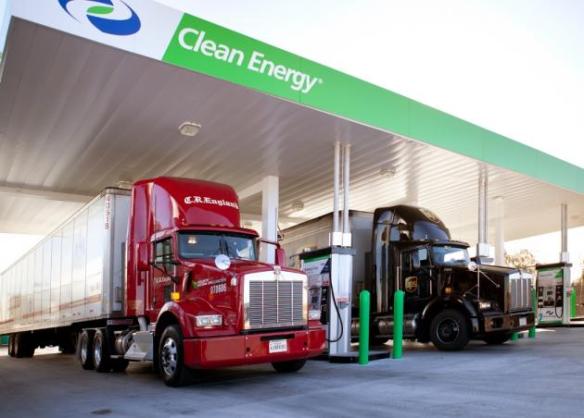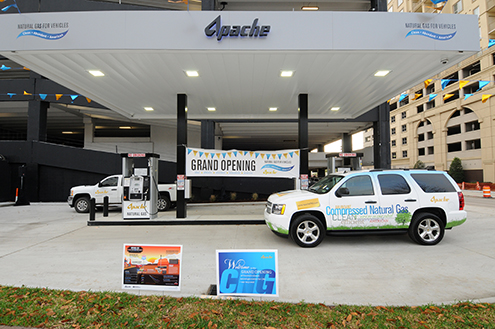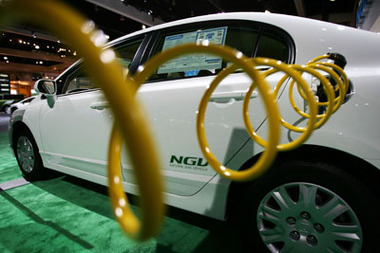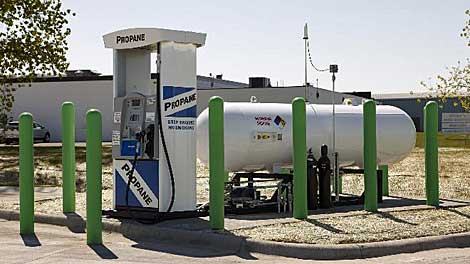
The push for compressed natural gas vehicles has gained some major traction with commitments from Ford, Chevrolet, Dodge and General Motors, but energy industry experts say federal incentives will be needed if real transformation is to occur.
“It is extremely nice to see that it’s actually here. A lot of times you talk about those things like they’re unicorns,” said Gifford Briggs, vice president of the Louisiana Oil and Gas Association. “But now they’re here …. I think that is a huge first step towards making it (CNG) a little more mainstream acceptable.”
The energy industry has felt good about the direction CNG has taken for a while, Briggs said, but the advent of mass-produced pickups that can run on natural gas or gasoline opens the door on a national scale.
Louisiana has seen CNG advances because of its Haynesville Shale natural gas formation, LOGA, the energy industry, and companies like Chesapeake Energy Corp., Encana Corp., Petrohawk Energy Corp. and Apache Corp., Briggs said. But trying to get Mississippi, Alabama and Florida and other states that don’t have the energy infrastructure to support CNG has been more challenging.
That may be changing. Twenty-two states are part of an effort, led by the governors of Oklahoma and Colorado, to encourage automakers to make more affordable CNG vehicles for state fleets. Oklahoma Gov. Mary Fallin has said the governors hope their efforts will help overcome some of the obstacles automakers face in producing a wider variety of CNG vehicles.
Oklahoma Energy Secretary Michael Ming said if the participating states could buy 5,000 CNG vehicles that would be great, but 1,000 is more likely given the current economic climate.
State government buys only about 40 percent of the public-sector vehicle purchases, Ming said. Municipalities and other political subdivisions account for 60 percent of sales.
If the municipalities — city and parish governments — tag along, the CNG sales could be significantly higher, Ming said.
Chris Knittel, an economist at the Massachusetts Institute of Technology, described the states’ request as “interesting.”
The states presume the CNG vehicles available aren’t that affordable, Knittel said.
“There’s no magic wand that the automakers can wave that makes the CNG vehicles less expensive than gasoline-based vehicles,” Knittel said.
“But there are things that policymakers can do to level the playing field.”
States have to put policies in place with incentives that encourage consumers to switch, he said. Those incentives could involve making CNG fueling stations available, subsidizing vehicles or in-home fueling stations, or by lowering retail prices for natural gas.
Right now, the states aren’t guaranteeing anything to automakers, Knittel said.
“I think the states are just saying that if you build them, we’ll promise the consumers,” Knittel said. “I’m not sure that’s necessarily the case given the current structure of prices and the number of refueling stations around.”
There are roughly 1,000 fueling stations nationwide, and 123,000 CNG vehicles, Ming said.
In Louisiana, CNG vehicles make up less than 1 percent of the cars and trucks on the road, Briggs said. Nationwide, CNG vehicles are around 2 percent of the total.
But that can change if the state, local and federal governments and the private sector — the companies that operate fleets — work together, he said.
“I don’t think the federal government or the state government or the local government can do it by themselves, any more than I think the fleets can do it by themselves,” Briggs said.
But working together can make things happen, Briggs said. Just look at Lafayette, where the city-parish government and private sector have joined to make the state’s most aggressive move to CNG.
In July, Apache opened a public fueling station. The company also converted 15 of its vehicles in Lafayette, part of 300 conversions it will complete by yearend. The city-parish has converted five buses and announced plans to convert its entire fleet.
The city-parish is also trying to form a partnership with the University of Louisiana at Lafayette and the local school boards to convert all their vehicles, Briggs said. Acadian Ambulance is experimenting with CNG for its vehicles.
The East Baton Rouge City-Parish Government recently began looking into converting all of its vehicles to CNG. The city-parish expects the move will slash fuel costs, particularly for heavy-duty pickups and other vehicles that consume more fuel.
Chesapeake spokeswoman Katie McCullin said there is evidence across Louisiana that the state is leading the nation in natural gas usage.
For example, Shreveport has added 14 natural-gas powered buses, and Bossier City has added a second public fueling station. Holmes Honda in Shreveport and Bossier City received its first shipment of the Honda Civic Natural Gas, the only dedicated CNG vehicle now sold in the United States.
In total there are 10 public CNG stations in Louisiana, with more in the planning stages or under construction, McCullin said.
Chesapeake, a major player in the Haynesville Shale and other natural gas plays, is one of the leading proponents of CNG.
The Oklahoma-based company’s Fueling the Future Initiative is an effort to communicate how natural gas can reduce greenhouse gas emissions and end the United States’ dependence on foreign oil, McCullin said.
The company has a billboard off Interstate 10 near the state Capitol extolling the use of natural gas vehicles.
Chesapeake has participated and sponsored natural gas vehicle seminars nationwide and is converting its 5,000-vehicle fleet to CNG, McCullin said. UPS, Verizon Wireless, Waste Management, Disneyland Resorts and AT&T are also converting their fleets to CNG; in 2009, AT&T announced it would spend $350 million to buy 8,000 CNG vehicles.
McCullin said Chesapeake will also invest at least $1 billion over the next 10 years with Clean Energy, 3M Corp., GE and Sundrop Fuels in efforts to increase demand for CNG vehicles.
The work with 3M could revolutionize the design and manufacture of CNG tanks, the most expensive part of the CNG fueling system, McCullins said. The redesign is expected to lead to lighter, more durable and less expensive tanks.
Chesapeake expects these investments to be the tipping point that gives automakers the confidence to increase their production of CNG and liquefied natural gas vehicles, McCullin said.
Still, both Briggs and Knittel said federal incentives are needed if natural gas is to replace oil as a transportation fuel.
The federal government would be the best source for those incentives, Knittel said, because the benefits from CNG vehicles accrue to the nation, not just to the states.
Energy independence and a reduction in climate change help everyone in the United States, regardless of whether a Louisiana resident buys CNG vehicle, he said.
“When the benefits accrue to everyone, the best place to set the policies is at the higher federal level,” Knittel said.
Briggs said if the country wants to see “a monumental shift,” then Congress should pass the Natural Gas Act.
The act replaces CNG incentives that dropped off the books about three years ago, Briggs said.
That was about the same time that Louisiana passed its own CNG vehicle incentives, Briggs said.
Right now, with only the state incentives, a Louisiana consumer can recover the $10,000 it costs to convert to CNG in two years if he drives 15,000 to 20,000 miles a year.
Most people don’t drive that much, Briggs said. But if both federal and Louisiana incentives were in place, converting a vehicle would be free, and consumers would begin saving money instantly.
“You’re saving a dollar, a dollar fifty, two dollars a gallon,” Briggs said.
“That would register with the American public overnight.”
Briggs pays around 45 cents per gallon by fueling up at LOGA’s office station, he said.
At Apache’s Lafayette station, the cost is around $1.79 a gallon, which is still only about half the price of gasoline.
Briggs said there is enormous support for the Natural Gas Act, but he doesn’t expect Congress to pass the legislation anytime soon.
And Knittel said any new policies that involve handing out more money have little chance in Congress these days.
“Still, I could certainly see both sides of the aisle supporting CNG,” Knittel said.
The rhetoric from both parties suggests they would support natural gas vehicles, he said.
Meanwhile, the price of natural gas is lower than it’s ever been, and with shale gas so plentiful, prices are expected to remain low for some time, Knittel said. In the past, natural gas prices have been very volatile; the price might fall but no one expected it to stay there.
Now, natural gas is expected to remain at less than $5 per thousand cubic feet for the foreseeable future, Knittel said.
Briggs said the United States is the Saudi Arabia of natural gas.
“We have more natural gas than we know what to do with. We’re trying to export it,” Briggs said.
The country has so much natural gas that it’s going to run out of storage capacity, Briggs said.
“I think if the federal government … is serious about eliminating our dependency on foreign oil, the only viable alternative is natural gas,” Briggs said.
Congress should pass the Natural Gas Act, he said.
“Let’s get it on the books, and let’s see if we can get started transforming America’s transportation infrastructure” Briggs said.
Source: The Advocate
Looking to get a cng station? Check us out http://www.fenleynicolenvir.com/cng.html










